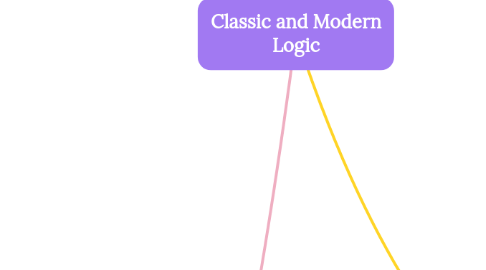
1. The Syllogism in Classical Logic
1.1. Humanity knows two historical moments of logic: The classical logic and modern logic.
1.1.1. In ancient times syllogism was known as deductive reasoning. It has three propositions: two premises and one conclusion.
1.1.2. Syllogism has three conditions.
1.1.2.1. The propositions are categorical. They contain a subject and a predicate that have relation between each other.
1.1.2.1.1. The boy is tall S P
1.1.2.2. The propositions can be affirmative or negative.
1.1.2.2.1. -The boy is tall --> It affirms thet the boy is tall -The boy is not tall --> It denied that the boy is tall
1.1.2.3. The propositions have quantifiers. They express the amount.
1.1.2.3.1. -Particular ( one, a hundred, enough, some) -Universal ( all, none)
1.2. There are four terms that compose syllogistic reasoning
1.2.1. Major Premiss
1.2.1.1. Predicate of the conclusion
1.2.2. Minor Premiss
1.2.2.1. Subject of the conclusion
1.2.3. Middle Term
1.2.3.1. It is not in the conclusion
1.2.4. Conclusion
1.2.4.1. The relation between the subject and predicate is established
1.3. Four types of propositions or judgments
1.3.1. S: Universal P: Particular
1.3.1.1. All the boys are tall
1.3.1.1.1. All S is P
1.3.2. S: Universal P: Universal
1.3.2.1. No boy is tall
1.3.2.1.1. All S is not P
1.3.3. S: Particular P: Particular
1.3.3.1. The boy si tall
1.3.3.1.1. Some S is P
1.3.4. S; Particular P: Universal
1.3.4.1. The boy is not tall
1.3.4.1.1. Some S is not P
1.4. Fallacies
1.4.1. They are incorrect and incomplete reasoning, becuas their complements are not true
1.4.1.1. Attack to the person
1.4.1.1.1. It refers to any condition of the person who issues an opinion.
1.4.1.2. Appeal to popularity
1.4.1.2.1. It supports an argument in popular opinion and not because they are godd.
1.4.1.3. False generalization
1.4.1.3.1. It generalize form very few observed cases
1.4.1.4. Petition of principle
1.4.1.4.1. It says the same idea many times. it doesn't prove anything.
1.4.1.5. Appeal to force
1.4.1.5.1. It uses the violence. It has no arguments.
1.4.1.6. Appeal to Emotions
1.4.1.6.1. It oves the feeling, it doesn't offer reasoning.
1.4.1.7. Appeal to ignorance
1.4.1.7.1. It uses the ignorance of something as an argument.
1.4.1.8. Appeal to authority
1.4.1.8.1. It is when an argument is taken as correct becuase it is given by a big person or institution.
2. Modern Logic and its Symbolic Language
2.1. Propositional Logic
2.1.1. This logic deals with analyzing formally valid reasonings based on their propositions.
2.1.2. Gottlob Frege proposed a logic of propositions or to get rid of interpretive ambiguisties and be much more accurate.
2.1.3. Example of propositional Logic: "If you exercise, then you will stay healthy".
2.2. Quantificational Logic
2.2.1. This logic focuses on the relationships between a quantity and the propositions, distinguishing between individuals and their predicates.
2.2.2. It uses expressions like "all" and "some" called "cuantifiers".
2.2.3. Example of Quantification Logic: "All students are smart", "Everyone" is a universal quantifier. "Some students are athletes", "Some" is aparticular quantifier.
2.3. Class Logic
2.3.1. This logic focuses on indicating the belonging or non-belonging of an element within a set, according to the properties it shares with it.
2.3.2. The class is the set of possible individuals that have a common property.
2.3.3. Classes are not propositions, so these sets cannot be true or false.
2.3.4. Example of Class Logic: "All dogs bark" is a sentence of the type " All S is P".
3. Aristotle was the one who proposed the syllogism in ancient Greece. He described it as a deductive structure.
4. concept of judgment and reasoning
4.1. thoughts and reasoning
4.1.1. thought: mental process that ocurs due to intelectual capacity
4.1.2. reasoning: intellectual capacity that is responcible for interrelate different vews to solve problems
4.2. concept: mental representation of an object
4.3. reasoning: implies coherent relation between two judgments
5. The Logical Principles of Judgements and Argument
5.1. Deductive Inference
5.1.1. Unlike the inductive inference, leads to necessary conclusions; part of the facts and absolute security. We generally make use of deductive inference when making the general statement of a problem or concern that we seek to solve.
5.2. Inductive Inference
5.2.1. We start from various observations made about the same fact or objetc, so that the conclusion is a statement that can be generalized to all cases that share properties obesrved so far
5.3. Conclusion
5.3.1. is a group of statements some of which, the premises, are offered in support of another statement, the conclusion.
5.4. Logic Principles
5.4.1. the principle of individuality, the precept of the excluded middle, the principle of sufficient understanding, and the principle of contradiction.
